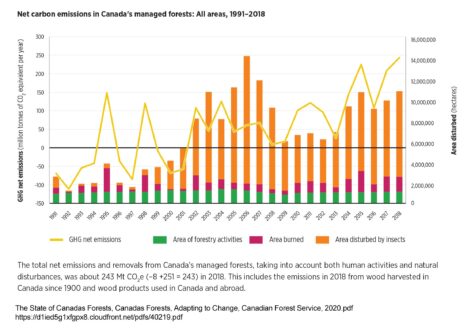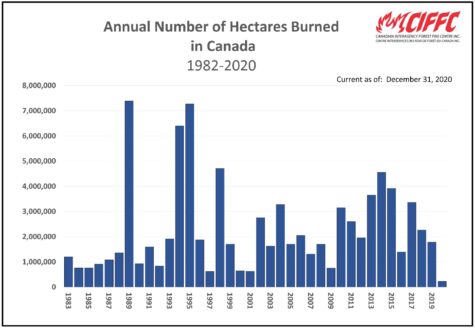
Canada’s Forests Have Flipped From Carbon Sink to Greenhouse Gas Emissions
There are 345 million hectares (857 million acres) of forest in Canada. Of these, 226 million hectares (558 million acres) are managed forest lands used for forest production. When the area of the great pine bark beetle attack grew above 4 million hectares per year in 2001 (10 million acres), the natural carbon sequestration of these managed forests could no longer keep up and the forest became an emitter of greenhouse gases.
The pine bark beetle is a native insect driven berserk from warming. Over 10,000 beetles can attack a single tree and its breeding success depends upon the beetles killing the tree. At the peak of the attack, 12 million hectares (30 million acres) per year were attacked with mortality ranging the low tens of percent to 95 percent.
After a decade the pine bark beetles had had their way with Canada’s forests and the attack declined because large areas of the beetles’ favored lodgepole pine had mostly already been attacked and killed. Then about 2014, new attacks began with new native beetles, the spruce and fir beetles. Area attacked every year has increased since, back up to between 7 and 8 million hectares (17 to 20 million acres.)
During the initial attack, Canada’s managed forests emitted between 50 and 100 million tons CO2eq, or the CO2 equivalent of all greenhouse gases. Since about 2014, emissions have risen to 150 million tons CO2eq per year, likely because of increasing fire. Prior to 2000, the managed forest sink sequestered 50 to 100 million tons Co2eq per year. And as a point of reference, the annual logged area is a little over 1 million hectares (2.5 million acres).
The image below from The State of Canada’s Forests Annual Report 2020, shows net emissions, not absorption, from Canada’s managed forests in 2018 hit a record of 243 million tons CO2eq.

The State of Canada’s Forests, Adapting to Change, Canadian Forest Service, 2020.
https://d1ied5g1xfgpx8.cloudfront.net/pdfs/40219.pdf
Part of the increase in emissions since 2014 has been an increase in acres burned. Prior to 2000, a typical season saw 1.5 million hectares (3.7 million acres) burn. After 2010 it has increased to 2.5 million hectares (6.2 million acres). In 2019 it was 1.8 million hectares (4.4 million acres).

Canada Report 2020, Canadian Interagency Forest Fire Center
https://www.ciffc.ca/sites/default/files/2021-02/Canada_Report_2020_Final.pdf
Astonishingly, according to the Canadian Forest Service, only 227 thousand hectares burned in 2020. This rivals the few lowest years of burn ever recorded back to the 1920s. Is this an artifact of reporting and Covid? It doesn’t seem to be so, but would we be surprised if it is? What would be surprising is if there is no Covid connection. Or is this too actually surprising with the unprecedented heat bomb in the Pacific Northwest and ice bomb in Texas?

Global Forest Fire Assessment, Food and Agriculture Organization, United Nations, 2001
http://www.fao.org/3/AD653E/ad653e86.htm#P16845_883629
